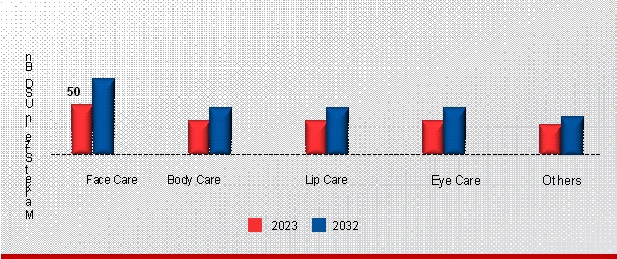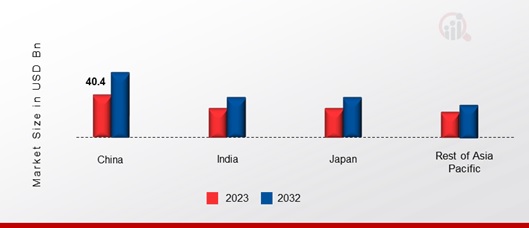Asia Pacific skin care Market Overview
Asia Pacific Skin Care Market Size was valued at USD 88.3 Billion in 2022. The Asia Pacific skin care market industry is projected to grow from USD 91.5 Billion in 2023 to USD 121.45 Billion by 2032, exhibiting a compound annual growth rate (CAGR) of 3.60% during the forecast period (2024 - 2032). Growing customer awareness of skin care practices is one of the major market drivers driving the skin care market in Asia Pacific.

Source: Basic Research, Secondary Research, MRFR Database and Analyst Review
Asia Pacific skin care Market Trends
- Growing customer awareness of skin care practices is driving market growth.
Asia Pacific cultures frequently prioritize skincare as a crucial component of their beauty regimens. Because having clear, healthy skin is widely prized, there is a big market for skincare products. The cosmetics industry has profited from the resurgence of self-care and hygiene practices. The primary drivers of the cosmetics market have been the rising need for self-care goods to address stress and anxiety, as well as consumers' propensity to engage in more self-care activities to feel and look better. Because it stresses altering their current skin care routine, the interest in natural and organic components has further raised user awareness of and demand for skin care products, including face masks, body scrubs, toners, and serums.
Furthermore, a quick and efficient way to get rid of products that don't follow rules and regulations is to recall cosmetics and beauty products from stores, especially if they pose a health risk. Such a product may be recalled for a number of reasons, including numerous customer complaints, noncompliance with regulatory bodies' guidelines governing ingredient usage, voluntary business recalls, and others. The world's population is becoming more and more accustomed to living as vegans. People are adopting this lifestyle to benefit their bodies on the inside as well as the outside, with the goal of improving their general health. These advancements are also having an impact on the cosmetics sector. Customers are actively looking for vegan cosmetics and making the switch.
Asia Pacific skin care Market Segment Insights
- Asia Pacific skin care Product Type Insights
The Asia Pacific skin care market segmentation, based on Product Type, includes Face Care, Body Care, Lip Care, Eye Care, and Others. The face care segment dominated the market. This is because Face creams serve as a layer of defense against outside influences. They can protect the skin from UV rays, environmental contaminants, and inclement weather. This defense mechanism lessens the harm that comes from environmental stimuli and preserves the integrity of the skin. Additionally, face creams provide a practical and adaptable everyday skincare solution.
Figure 1: Asia Pacific skin care Market, by Product Type, 2023 & 2032 (USD Billion)

Source: Basic Research, Secondary Research, MRFR Database and Analyst Review
Asia Pacific skin care Gender Insights
The Asia Pacific skin care market segmentation, based on Gender, includes Male and Female. The female category generated the most income. This is because Women's appearance is frequently given more weight by societal norms and cultural expectations, which raises the demand for skin care products. In addition, women usually have a greater variety of skincare requirements and issues to address. Menopause, pregnancy, and hormonal fluctuations can all have a major effect on the skin and call for certain solutions.
Asia Pacific skin care Sales Channel Insights
The Asia Pacific skin care market segmentation, based on Sales Channel, includes Supermarkets/Hypermarkets, Specialty Stores, Online, and Others. The supermarkets/hypermarkets category generated the most income. This is because Supermarkets and hypermarkets are great places to do business with a wide range of customers because of their many advantages. These advantages include competitive pricing, a prominent display of well-known international brands, and increased freedom of choice for customers.
Asia Pacific skin care Country Insights
The demand for skincare products is being driven by the growing health consciousness and awareness of skincare among Chinese consumers, especially the younger population. Asia Pacific's rapid urbanization has raised environmental pollution exposure, which has raised concerns about skincare and the need for restorative and protective solutions. Furthering the market expansion is the ease with which consumers can now access and discover new skincare brands in China and products because of the advent of e-commerce and social media platforms. The emergence of reasonably priced treatment alternatives is anticipated to fuel market expansion as well. The expansion in the number of large multinational firms engaging in research and development has been one of the main forces for the region's industrial expansion. Furthermore, Growing awareness of beauty in both men and women is expected to boost the local economy.
Figure 2: Asia Pacific Skin Care Market Share By Region 2023 & 2032 (USD Billion)

Source: basic Research, Secondary Research, MRFR Database, and Analyst Review
Asia Pacific skin care Key Market Players & Competitive Insights
Leading market players are putting a lot of money into R&D to increase the range of products they sell, which will support further growth in the Asia Pacific skin care market. In addition, market players are engaging in a range of calculated initiatives to increase their presence, with significant market developments involving the introduction of new products, contracts, M&A transactions, increased investment, and cooperation with other enterprises. To grow and endure an increasingly cutthroat and dynamic market, the Asia Pacific skin care industry must provide reasonably priced goods.
Major players in the Asia Pacific skin care market are engaging in research and development activities in an effort to boost market demand, including Unilever PLC, L'Oreal S.A., Shiseido Company, Limited, the Estée Lauder Companies, Procter & Gamble Co., Kao Corporation.
Key Companies in the Asia Pacific skin care market include.
- Unilever PLC
- L'Oreal S.A.
- Shiseido Company, Limited
- The Estée Lauder Companies
- Procter & Gamble Co.
- Kao Corporation
- Colgate-Palmolive Company
- Oriflame Cosmetics Global SA
- Beiersdorf AG
- Johnson & Johnson Services, Inc.
Asia Pacific skin care Industry Developments
August 2021: The digitally driven skin care firm Paula's Choice has been acquired by Unilever. The company is well-known for its cutting-edge inventions, easily understandable science devoid of jargon, effective ingredients, and cruelty-free goods.
March 2021: Coty Inc. revealed its collaboration with LanzaTech, a manufacturer of cutting-edge sustainable and ecological products. As a result, the businesses will spend money adding sustainable ethanol produced from captured carbon emissions into their scent offerings.
Asia Pacific skin care Market Segmentation
Asia Pacific skin care Product Type Outlook
- Face Care
- Body Care
- Lip Care
- Eye Care
- Others
Asia Pacific skin care Gender Outlook
Asia Pacific skin care Sales Channel Outlook
- Supermarkets/Hypermarkets
- Specialty Stores
- Online
- Others
Asia Pacific skin care Regional Outlook
- China
- Japan
- India
- Australia
- South Korea
- Indonesia
- Thailand
- Vietnam
- Malaysia
- Singapore
-
Rest of Asia Pacific-Pacific
|
Report Attribute/Metric
|
Details
|
|
Market Size2022
|
USD 88.3 Billion
|
|
Market Size 2023
|
USD 91.5 Billion
|
|
Market Size2032
|
USD 121.4 Billion
|
|
Compound Annual Growth Rate (CAGR)
|
3.60% (2024-2032)
|
|
Base Year
|
2023
|
|
Market Forecast Period
|
2024-2032
|
|
Historical Data
|
2019- 2022
|
|
Market Forecast Units
|
Value (USD Billion)
|
|
Report Coverage
|
Revenue Forecast, Market Competitive Landscape, Growth Factors, and Trends
|
|
Segments Covered
|
Type, Gender, Sales Channel, and Region
|
|
Region Covered
|
Asia Pacific
|
|
Countries Covered
|
China, Japan, India, Australia, South Korea, Indonesia, Thailand, Vietnam, Malaysia, Singapore, Rest of Asia Pacific-Pacific
|
|
Key Companies Profiled
|
Unilever PLC, L'Oreal S.A., Shiseido Company, Limited, The Estée Lauder Companies, Procter & Gamble Co., Kao Corporation
|
|
Key Market Opportunities
|
· Growing consumer desire for the availability of personalized cosmetics and beauty goods
|
|
Key Market Dynamics
|
· Growing customer awareness of skin care practices
· the rising need for self-care goods to address stress
|
Frequently Asked Questions (FAQ) :
The Asia Pacific skin care market size was valued at USD 91.5 Billion in 2023.
The market is projected to grow at a CAGR of 3.60% during the forecast period 2024-2032.
The key players in the market are Unilever PLC, L'Oreal S.A., Shiseido Company, Limited, The Estée Lauder Companies, Procter & Gamble Co., and Kao Corporation.
The Female category dominated the market in 2023.
The Face Care category had the largest share of the market.





























